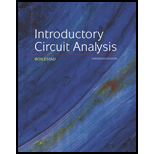
Concept explainers
a. Find the electric field strength at a point 1 m from a charge of 4
b. Find the electric field strength at a point 1 mm [1/1000 the distance of part (a)] from the same charge as part (a) and compare results.
(a)
The electric field strength at a point
Answer to Problem 1P
The electric field strength at a point
Explanation of Solution
Given:
The distance is
The charge is
Concept used:
Expression for the electric filed due to a point charge.
Here,
Calculation:
Substitute
Conclusion:
Thus, the electric field strength at a point
(b)
The electric field strength at a point
Answer to Problem 1P
The electric field strength at point
Explanation of Solution
Given:
The distance is
The charge is
Calculation:
Substitute
Therefore, the electric field strength at a point
Conclusion:
Thus, the electric field strength at point
Want to see more full solutions like this?
Chapter 10 Solutions
Introductory Circuit Analysis (13th Edition)
Additional Engineering Textbook Solutions
Elementary Surveying: An Introduction To Geomatics (15th Edition)
Vector Mechanics for Engineers: Statics and Dynamics
Starting Out With Visual Basic (8th Edition)
Vector Mechanics for Engineers: Statics
Mechanics of Materials (10th Edition)
Thinking Like an Engineer: An Active Learning Approach (4th Edition)
- 1. You are to design a 9-volt battery operated baseband PAM communication system that must last great than 10 years without replacing the batteries. The application requires a BER of <10^-4 and a data rate of 200bps. The channel can be modeled as AWGN with a noise power spectral density of 10^-9 W/Hz and a channel loss of 10 dB. (a) Estimate the required capacity of the batteries. (The battery life (hours) is equal to the battery volts times of the battery capacity (Amps* hours) divided by the total load (Watts)) and (b) Can you easily find this battery? If not, what would you suggest be done?arrow_forward3. You are on a design team tasked to design a system of remote sensors that use PAM. Here is what the team knows/assumptions: The remote sensor will use a single AA battery required to power the sensors. The system has a bandwidth of 2KHz and requires a data rate of 12 Kbps and a BER of less than 1*10^-4. The typical channel has maximum losses of 35 dB and a noise power spectral density is 10^-9 W/Hz. Your boss assigns you with the task of estimating how long the battery will last.arrow_forward2. The noise power (in watts) measured in a baseband PAM communication channel is 230*10^-6 Watts. The transmitter output power is 600 mW and has a data rate of 300 Kbps. The channel bandwidth is 100 KHz with losses that can be modeled as 0.5dB/meter. The application requires a BER ofarrow_forwardQ21arrow_forwardI need help with this problem and an step by step explanation of the solution from the image described below. (Introduction to Signals and Systems)arrow_forwardI need help with this problem and an step by step explanation of the solution from the image described below. (Introduction to Signals and Systems)arrow_forwardI need help with this problem and an step by step explanation of the solution from the image described below. (Introduction to Signals and Systems)arrow_forwardI need help with this problem and an step by step explanation of the solution from the image described below. (Introduction to Signals and Systems)arrow_forwardI need help with this problem and an step by step explanation of the solution from the image described below. (Introduction to Signals and Systems)arrow_forwardarrow_back_iosSEE MORE QUESTIONSarrow_forward_ios
 Electricity for Refrigeration, Heating, and Air C...Mechanical EngineeringISBN:9781337399128Author:Russell E. SmithPublisher:Cengage Learning
Electricity for Refrigeration, Heating, and Air C...Mechanical EngineeringISBN:9781337399128Author:Russell E. SmithPublisher:Cengage Learning
